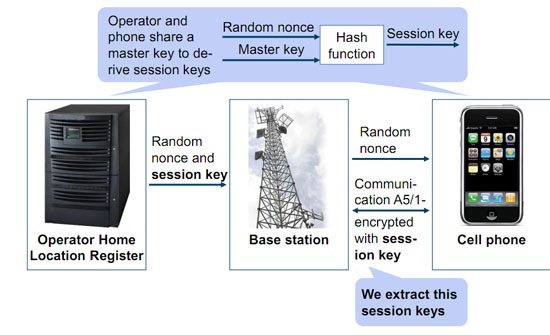A Vulnerability
was discovered in GSM networks — the same type of network T-Mobile and AT&T
operate on — that could allow for a hacker or an otherwise nefarious character,
to gain full remote control of any smartphone running on those types of
networks (Sprint and Verizon are in the clear).
The
security flaw was revealed during a hacking convention in Berlin where the head
of Germany’s Security Research Labs, a Mr. Karsten Nohl, said that the attacks
could easily be carried out on a large scale as well.
Hijacked
phones could allow for hackers to send text messages or even make phone call,
signing up users for expensive premium phone or messaging services, all without
the owner’s consent.
GSM Network Sniffer
By sniffing the network while sending a target phone an SMS, they were able to determine precisely which random network ID number belonged to the target. This gave them the ability to identify which of the myriad streams of information they wanted to record from the network. After that, the next step is essentially decrypting the information. ITs not that easy, but was made possible by the way operator networks exchange system information with their phones.


By sniffing the network while sending a target phone an SMS, they were able to determine precisely which random network ID number belonged to the target. This gave them the ability to identify which of the myriad streams of information they wanted to record from the network. After that, the next step is essentially decrypting the information. ITs not that easy, but was made possible by the way operator networks exchange system information with their phones.

As part of this background communication, GSM
networks send out identifying information, as well as “keepalive” messages and
empty spaces are filled with buffered bytes. Truth be told, a new GSM standard
was put in place several years ago to turn these buffers into random bytes,
they in fact remain largely identical today, under a much older standard.
Sticking to older standards enabled hackers to predict with a high degree of
probability the plain-text content of these encrypted system messages. This,
combined with a 2 terabyte table of pre-computed encryption keys (a so-called
rainbow table), allows a cracking program to discover the secret key to the
session’s encryption in about 20 seconds.

Many GSM operators reuse these session keys for
several successive communications, allowing a key extracted from a test SMS to
be used again to record the next telephone call, minimizing the need for
recomputation.
The process was demonstrated using their
software to sniff the headers being used by a phone, extract and crack a
session-encryption key, and then use this to decrypt and record a live GSM call
between two phones in no more than a few minutes.
Can something be done about
GSM’s security?
Any geek can make such devices and with the help
of the open source software, can mimic these hacks. So can we really do
something to prevent these kinds of hacks from happening?
“Much of this vulnerability could be addressed
relatively easily”, Nohl said. “Operators could make sure that their network
routing information was not so simply available through the Internet. They
could implement the randomization of padding bytes in the system information
exchange, making the encryption harder to break. They could certainly avoid
recycling encryption keys between successive calls and SMSs”.
“This is all a 20-year-old infrastructure, with
lots of private data and not a lot of security,” he said. “We want you to help
phones go through the same kind of evolutionary steps that computers did in the
1990s.”
Worst part is, all the current 3G phones are NOT
shielded from this hack. Knowing that 3G is primarily used for Data, its now
easy to capture any 3G user’s online activity including their passwords and
credit card numbers.
If you’re feeling a little bit more paranoid about who could be out there tapping your phone it should be said that Nohl also mentioned carriers could easily patch the security hole simply by updating their outdated software.
© BGR

No comments:
Post a Comment